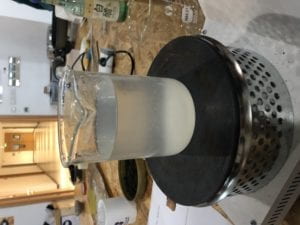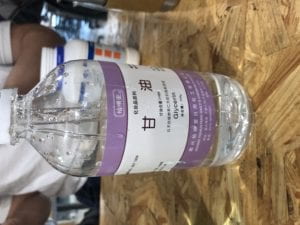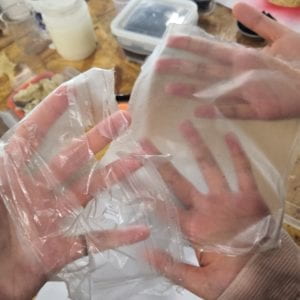Workshop Reflection
Recipe (Ingredients):
- 4 gram Agar Agar
- 2.5 ml Glycerol
- 420 ml Water
Our group’s work is to make Agar bioplastic. Our ingredients include Agar-Agar, glycerol, and water. The process of mixing them is easy, however, we failed to get the result till the end of the class since heating the mixture to 95 degrees celsius (Instructions: step two: put the pot on the stove and heat the mixture to 95 degrees or to just below boiling. Keep stirring the whole time) causes too long. Our final temperature reaches around 73 degrees, and there was already some solid, but humid and soft things coming out. We also need to keep stirring to make sure there are no bubbles in the liquid. The process of making the bioplastic material needs waiting, and the cost of time is truly high. Indeed, as Biomimicry has argued, “nature’s solutions are more efficient, more sustainable, and create no waste”.

The recipe of Agar bioplastic

The boiling process

Tools for the experiment

Ingredient: Glycerol

Ingredient: Agar Agar
What’s more, since all the materials come from nature itself, and the Agar bioplastic we create can be fully degraded, it is proved that “nature can serve both as a source of inspiration and a source of materials and processes that we can use and emulate to create better more sustainable solutions”. However, according to The truth about plastics, “while bioplastics are generally considered to be more eco-friendly than traditional plastics, a 2010 study from the University of Pittsburgh found that wasn’t necessarily true when the materials’ life cycles were taken into consideration”. The creation of the bioplastic costs too long, and the final product, the agar bioplastic does not seem to be something that can last very long either. I guess that’s also why bioplastic is still under the stage of discovery, but not to production, or use in our daily lives.
Step three:
Pour liquid onto a flat surface or mold… Let dry for 1-2 days, depending on temperature and humidity levels.
Week 11 update experiment result: In the class the following week, we received our final agar plastic. Because there was too much water in one container last week, we split them into two containers. However, the one with more shallow water surface produces less bio-plastic and it is too soft that it breaks when we tried to take it down. Another one tends to be much stronger, hard to tear. I think when doing the experiment, two factors are that we need to really boil it, at least to 95 degrees, and we cannot expect too little amount of ingredients to produce solid plastic. Therefore, plenty of raw materials is especially important.

Comparison of two pieces of Agar bio-plastic

The more durable one
Final proposal
Questions:
What do I think I can do/invent to improve Shanghai (the range can be smaller, e.g. our school building) trash sorting/city developing?
1.Bio-plastic for the plastic bags in the trash bin in the subway station and other places, especially for household trash (but the cost is too high)
Why this: After Shanghai has published its trash sorting policy, in most neighborhoods household trash cannot be thrown away with the plastic bag. But for most families household trash are wet, dirty and with a bad smell, so it is hard to deal with it. Some people can take trash within the container and pour them into the trash bin, but it is not feasible for people who go to work every day. The related department said they have thought about using degradable plastic bags, but those bags can only be degraded under certain conditions and usually takes 1-2 weeks, therefore it cannot be mixed with the household trash, and the cost of degradable plastic is also too high.

Inspiration comes from the trash bin in the subway station in SH

Trash bin in SH subway stations
A report of 破袋(not using the plastic bag) for household trash
About household trash in Shanghai
What we need: a kind of bio-plastic that is durable (so it won’t break) but also easily degradable, while the cost is low enough, which means the ingredients need to be cheap. If the degradable is hard to achieve, we can only consider the situation when landfilling household trash.
Possible materials: Agar bioplastic – simmered
2. Using recycled paper to make a notebook/print/souvenir/decoration (at NYU Shanghai store or bigger range and when people finish the notebook they can use the old one to change for a new one with a discount, also provide some services like having an e-document for the notebook)
Why this: Everyday there is so much wasted paper (academical trash) being produced inside the ab and students like purchasing notebooks from the campus store. If we build a circle between these two, the circle will save a large amount of paper.
What we need: used paper, board (to place paper pulp)
Week 11 update: I decided to take this one as I am going to do in the following weeks.
Hypothesis: By remaking paper, it will gradually build a circle of paper using inside the school, as well as contributing to other areas that can use remade materials (not 100% achievable but I will test).
3. Home-made clay/ beer spent grain composite / Cork | agar – starch Cor03 to make degradable flower pot that can truly grow plants, which can replace the plastic pots on the street.

Flowers for the urban landscape design

The pots used for the urban landscape design
Why this: To avoid the use of one-time plastic, and help the flower grows better
What we need: the ingredients from the recipe
Leave a Reply